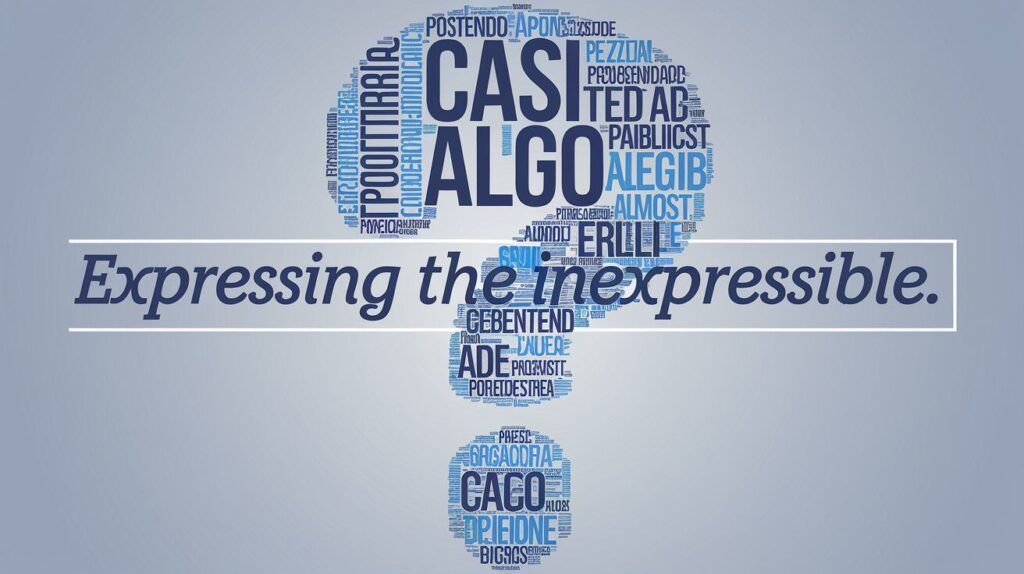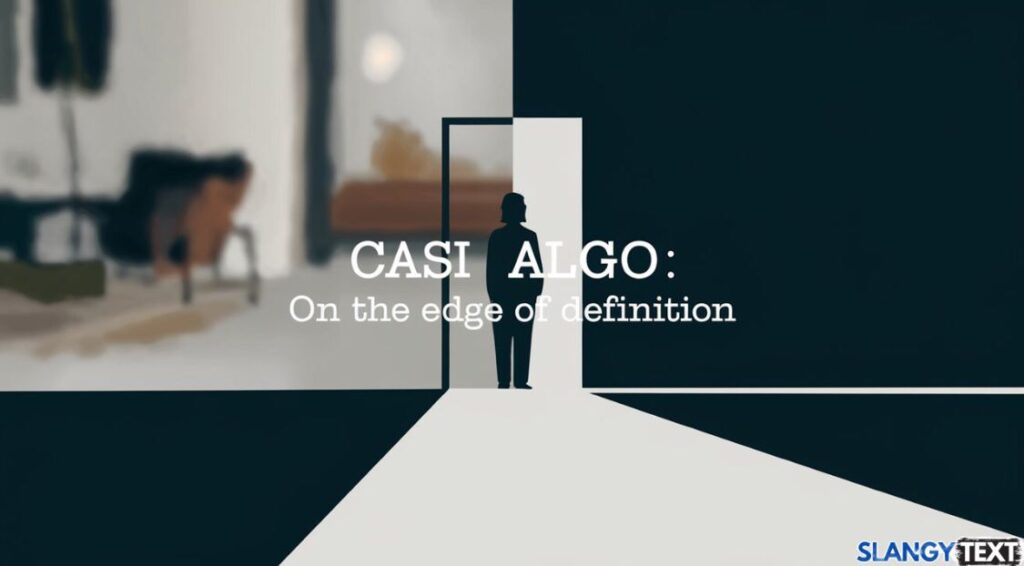In the ever-evolving landscape of language and communication, certain phrases capture our attention and pique our curiosity. One such intriguing term that has been making waves in both Spanish and English-speaking circles is “Casi Algo.”
This seemingly simple phrase carries a depth of meaning that transcends literal translation, offering insights into human interactions, relationships, and the nuances of cross-cultural communication.
The Essence of Casi Algo
At its core, casi algo is a Spanish term that literally translates to “almost something” in English. However, like many linguistic expressions, its meaning extends far beyond this basic interpretation. The phrase encapsulates a state of uncertainty, a situation teetering on the edge of definition, or a relationship that hasn’t quite solidified into a tangible form.
Unpacking the Meaning
To truly grasp the concept of casi algo, one must delve into its various applications and the contexts in which it thrives. This phrase finds its home in conversations about relationships, personal achievements, and even professional endeavors. It’s the verbal equivalent of standing on the threshold, not quite in or out, but somewhere in between.
Casi Algo in Everyday Communication

Texting and Digital Discourse
In the realm of digital communication, casi algo has found fertile ground. It’s a go-to phrase for those navigating the often murky waters of modern relationships, especially in the early stages of getting to know someone.
Consider this scenario: Emma has been messaging Jake for a few weeks. They’ve shared laughs, deep conversations, and even made tentative plans to meet. When her friend Sophia asks about Jake, Emma might respond, “It’s casi algo. We’re talking, but it’s not official yet.”
This usage perfectly encapsulates the uncertainty and potential of their budding connection. It’s more than nothing, but not quite something concrete.
Social Media Nuances
The concept of casi algo has seamlessly integrated into social media platforms, where relationships and statuses are often fluid and undefined. On platforms like Instagram, TikTok, and the X platform, users might use the phrase to describe connections that exist primarily in the digital sphere.
For instance, a TikTok creator might make a video about their “casi algo” relationship with a follower who consistently comments on their posts. It’s a playful acknowledgment of a connection that exists but hasn’t materialized into a real-world relationship.
You might also like : What Dos ICL Mean?
Casi Algo in Personal Relationships
The Dating Dilemma
Perhaps nowhere is the concept of casi algo more prevalent than in the world of dating and relationships. It perfectly describes that liminal space between friendship and romantic partnership, where feelings are developing but haven’t been explicitly defined or acted upon.
Let’s explore some common scenarios where casi algo might come into play:
| Scenario | Person A | Person B | Casi Algo Context |
|---|---|---|---|
| Coffee Dates | Michael | Sarah | Regular coffee meetups, but no official dates |
| Work Colleagues | David | Jennifer | Flirtatious banter at work, but no outside interaction |
| Gym Buddies | Ethan | Olivia | Workout together often, subtle flirting |
| Childhood Friends | Daniel | Sophia | Reconnected as adults, hint of romance |
| Online Match | Christopher | Isabella | Daily chats, but haven’t met in person |
| Mutual Friends | William | Ava | Hang out in group settings, clear chemistry |
| Study Partners | Benjamin | Mia | Late-night study sessions with unspoken tension |
| Neighbor | James | Charlotte | Frequent neighborly chats, growing attraction |
| Dance Class Partners | Alexander | Amelia | Weekly dance lessons, increasing closeness |
| Book Club Members | Joseph | Harper | Intellectual connection during meetings, lingering glances |
In each of these scenarios, the individuals involved might describe their relationship as casi algo. It’s more than a casual acquaintance but hasn’t crossed the threshold into a defined romantic relationship.
Friendship on the Brink
Casi algo isn’t limited to romantic contexts. It can also describe friendships that are on the verge of becoming deeper or more significant. For example, two colleagues who have started spending time together outside of work might refer to their relationship as casi algo, acknowledging that it’s evolving beyond a purely professional connection.
The Language of Uncertainty

Expressing the Inexpressible
One of the beauties of the phrase casi algo is its ability to convey complex emotions and situations succinctly. It’s a linguistic tool that allows speakers to express uncertainty without committing to a definitive statement. This can be particularly useful in situations where clarity is elusive or where individuals are hesitant to define their circumstances too rigidly.
Cultural Context and Usage
While casi algo originates from Spanish, its usage has begun to transcend language barriers. As with many slang terms and colloquialisms, it has found its way into the lexicon of English speakers, particularly those in multicultural environments or areas with significant Spanish-speaking populations.
This cross-pollination of language highlights the importance of cultural understanding in modern communication. For non-native Spanish speakers, grasping the nuances of casi algo can provide insights into Latino culture and communication styles.
Casi Algo in Professional Settings

The Almost Deal
Interestingly, the concept of casi algo has applications beyond personal relationships. In the business world, it can describe negotiations or deals that are close to fruition but not quite finalized. Let’s look at some professional scenarios where casi algo might apply:
| Industry | Professional A | Professional B | Casi Algo Context |
|---|---|---|---|
| Real Estate | Robert (Agent) | Emily (Buyer) | Verbal agreement, pending paperwork |
| Tech Startup | Andrew (Founder) | Natalie (Investor) | Positive meetings, awaiting final pitch |
| Publishing | Thomas (Author) | Sophia (Publisher) | Manuscript under review, contract not signed |
| Corporate Merger | Daniel (CEO) | Olivia (Board Member) | Preliminary talks, due diligence ongoing |
| Freelance Work | Christopher (Designer) | Isabella (Client) | Project discussed, proposal not accepted yet |
| Academic Research | William (Professor) | Ava (Grant Committee) | Promising research, funding not confirmed |
| Sports | Benjamin (Athlete) | Mia (Team Manager) | Contract negotiations in progress |
| Music Industry | James (Artist) | Charlotte (Label Rep) | Demo submitted, awaiting label decision |
| Film Production | Alexander (Director) | Amelia (Producer) | Script approved, budget under discussion |
| International Trade | Joseph (Exporter) | Harper (Importer) | Terms agreed verbally, contracts not finalized |
In these professional contexts, casi algo encapsulates the delicate balance of potential and uncertainty that often characterizes business dealings.
You might like to read this too: What Does NTM Mean?
Career Transitions
The phrase can also apply to career situations where an individual is on the brink of a significant change. For instance, an employee who has had promising interviews for a new position but hasn’t received a formal offer might describe their situation as casi algo. It’s an acknowledgment of progress and potential without the certainty of a confirmed outcome.
The Psychology of Casi Algo
Embracing Ambiguity
The popularity of the term casi algo speaks to a broader human tendency to find comfort in ambiguity. In a world that often demands clear-cut definitions and commitments, casi algo offers a linguistic safe haven. It allows individuals to acknowledge the existence of a connection or situation without the pressure of defining it concretely.
The Power of Potential
There’s a certain allure to the state of casi algo. It’s ripe with possibility, unmarred by the reality of concrete definition. In relationships, this state can be both exciting and frustrating, filled with the thrill of what might be. In professional contexts, it can represent the cusp of breakthrough or success.
Casi Algo Across Cultures
Language Proficiency and Understanding
The spread of casi algo beyond Spanish-speaking communities highlights the increasing language proficiency of global citizens. As more people become bilingual or multilingual, phrases like casi algo find their way into diverse linguistic contexts.
Here’s a look at how casi algo might be understood and used across different language backgrounds:
| Native Language | Speaker | Understanding of Casi Algo |
|---|---|---|
| English | Emma | Uses it to describe ambiguous dating situations |
| Spanish | Javier | Natural usage in various contexts |
| French | Sophie | Learned it from Spanish-speaking friends |
| Mandarin | Wei | Uses it in international business contexts |
| Arabic | Fatima | Picked it up from social media |
| German | Hans | Uses it when discussing cross-cultural relationships |
| Japanese | Yuki | Learned it while studying abroad in Spain |
| Portuguese | Mateo | Natural understanding due to linguistic similarities |
| Russian | Anastasia | Uses it in her work as a translator |
| Hindi | Raj | Learned it from Latino colleagues in tech industry |
This table illustrates how casi algo has transcended its Spanish origins to become a tool for expressing nuanced situations across various cultures and languages.
Bridging Communication Gaps
In multicultural settings, phrases like casi algo can serve as bridges, helping to convey complex ideas that might not have direct translations in other languages. This linguistic flexibility is particularly valuable in our increasingly globalized world, where clear communication across cultural boundaries is essential.
The Evolution of Language
From Slang to Mainstream
The journey of casi algo from a colloquial Spanish phrase to a widely recognized term exemplifies the dynamic nature of language evolution. What begins as slang or jargon within a specific community can quickly become part of mainstream discourse, especially in the age of social media and rapid information exchange.
Digital Influence on Language
The rise of digital communication platforms has accelerated the spread and adoption of phrases like casi algo. Social media, in particular, has played a crucial role in popularizing and contextualizing the term for a global audience.
Consider how casi algo might be used across different social media platforms:
| Platform | User | Casi Algo Usage |
|---|---|---|
| Lily | Caption: “Movie night with the casi algo 😉” | |
| TikTok | Ethan | Video: “POV: Your casi algo likes someone else’s post” |
| X Platform | Olivia | Tweet: “Casi algo status update: We finally went on a real date!” |
| Noah | Status: “It’s complicated… #CasiAlgo” | |
| Sophia | Post: “Exciting casi algo opportunity in the works! #CareerMoves” | |
| Snapchat | Liam | Story: “Guess who I’m getting coffee with? #CasiAlgo” |
| Ava | Status: “In a casi algo situation. Don’t ask.” | |
| YouTube | Mason | Video Title: “How to Know If You’re in a Casi Algo Relationship” |
| Isabella | Board: “Casi Algo Date Ideas” | |
| Lucas | Thread: “r/relationships: Is my casi algo leading nowhere?” |
This table showcases how casi algo has been integrated into various social media contexts, reflecting its versatility and widespread adoption in digital communication.
You might like to read this too: What does DTN Mean?
The Art of Interpreting Casi Algo

Context is Key
Understanding and interpreting casi algo requires a nuanced approach. The meaning can vary significantly depending on the context of the conversation and the relationship between the speakers. What might be a playful, non-committal casi algo in one situation could be a serious acknowledgment of developing feelings in another.
Cultural Sensitivity in Communication
As casi algo gains traction in cross-cultural communication, it’s important to approach its usage with cultural sensitivity. What works as a casual, ambiguous term in one culture might be perceived differently in another. This underscores the importance of cultural understanding in effective global communication.
Casi Algo in the Workplace
Professional Ambiguity
In professional settings, casi algo can describe projects or initiatives that are in development but not yet fully realized. It’s a useful term for discussing potential collaborations or opportunities that are still taking shape.
Here’s how casi algo might manifest in various professional scenarios:
| Industry | Professional A | Professional B | Casi Algo Situation |
|---|---|---|---|
| Marketing | Sarah (Manager) | David (Client) | Campaign concept pending approval |
| Software Development | Michael (Developer) | Jennifer (Project Manager) | Feature in beta testing phase |
| Education | Emma (Teacher) | Jake (Principal) | New curriculum under consideration |
| Healthcare | Dr. Olivia | Dr. Ethan | Joint research paper in draft stage |
| Finance | William (Analyst) | Sophia (Investor) | Promising investment opportunity being vetted |
| Hospitality | Chef Daniel | Restaurant Owner Ava | New menu items in development |
| Architecture | Architect Benjamin | Client Mia | Building design in initial sketch phase |
| Journalism | Reporter James | Editor Charlotte | Breaking story awaiting final verification |
| Fashion | Designer Alexander | Buyer Amelia | Collection preview, orders not yet placed |
| Non-Profit | Director Joseph | Donor Harper | Grant proposal under review |
This table illustrates the diverse applications of casi algo in professional contexts, highlighting its utility in describing projects or relationships that are in a state of development or transition.
Navigating Workplace Relationships
In the context of workplace relationships, casi algo can describe professional connections that are evolving beyond typical colleague interactions. It might be used to describe mentorship relationships that are forming organically or potential collaborations that are still in the discussion phase.
The Future of Casi Algo
Linguistic Integration
As global communication continues to evolve, phrases like casi algo are likely to become more integrated into multilingual discourse. This trend reflects the increasing interconnectedness of our world and the blending of cultural and linguistic elements.
Expanding Contexts
While casi algo currently finds its primary use in discussions of relationships and professional situations, its application may expand to other areas of life. As people become more comfortable with states of ambiguity and transition, the phrase could find new contexts and meanings.
Embracing the In-Between
In a world that often demands clear definitions and commitments, casi algo offers a refreshing acknowledgment of life’s inherent ambiguities. It’s a linguistic tool that allows us to express the inexpressible, to acknowledge potential without demanding immediate resolution.
Whether used in personal relationships, professional settings, or casual conversation, casi algo reminds us that not everything needs to be clearly defined. Sometimes, the beauty lies in the journey, in the potential, in the almost-something that might, one day, become something more.
As we navigate the complexities of modern communication, phrases like casi algo serve as bridges between languages, cultures, and experiences. They remind us of the rich tapestry of human interaction, where meanings are often layered and nuanced, and where the spaces between defined states can be just as significant as the states themselves.
In embracing casi algo, we embrace the uncertainty and potential that color our lives. We acknowledge that relationships, projects, and even our own personal growth are often works in progress, beautiful in their incompleteness and ripe with possibility.
So the next time you find yourself in a situation that defies easy categorization, remember the concept of casi algo. It’s more than just a phrase; it’s a celebration of the in-between, a recognition of the journey, and an acknowledgment that sometimes, the most interesting parts of life are the ones we’re still figuring out.
You might like to read this too: What Does Fuckletoes Mean?

Kayla Rogers is a writer at Slangy Text who loves exploring modern acronyms & slangs and how they shapes our conversations. She enjoys sharing fun and interesting articles that connect with readers. When she’s not writing, Kayla likes to keep up with the latest trends or relax with a good book.







